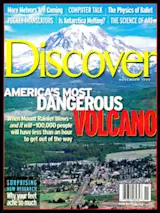On a sunny Saturday afternoon in June, John Anderson, a 43-year-old sawmill worker, sits in front of his pretty green-trimmed house in a family-friendly subdivision in Orting, Washington, not far from Seattle. He gazes contentedly down the street, scratching his neat goatee and watching the neighborhood kids shoot hoops in a driveway. It's an ordinary day in suburban America, but here in Orting, behind every house, mostly ignored, is 14,410-foot-high, snowcapped Mount Rainier. This is one of the continent's most spectacular sights: a mountain that seems to loom and then recede, sometimes crisply focused and near enough to touch, at other times shifting into the fog, vanishing, then reappearing. "When we get a full moon and it comes up over the mountain, it's really something," says Anderson, leading a visitor into the backyard for a better view.
Anderson takes Rainier for granted. The mountain views came with the house, which ...














